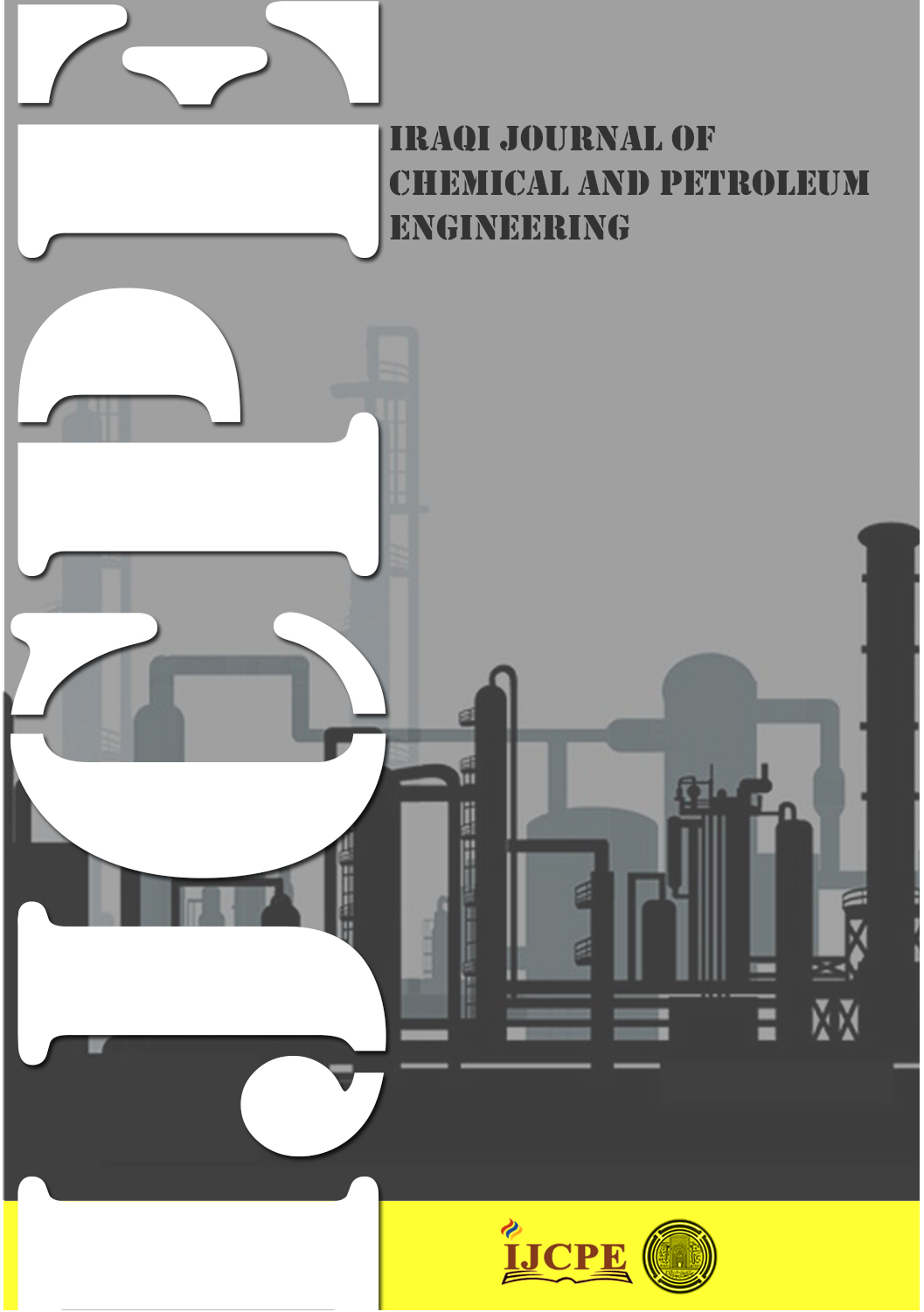Characterization of catalyst enzyme by covalent binding chemical immobilization functions on a novel support surface
DOI:
https://doi.org/10.31699/IJCPE.2025.1.10Keywords:
Chemical characteristic; Cabbage legs peroxidase; Covalent binding technique Immobilization; Biocatalyst enzymes; Sold supportsAbstract
Cabbage legs peroxidase was used in this study as an economical peroxidase enzyme. Inorganic low-cost supports surfaces such as black stone BS, sand S and quartz rock QR, were utilized to immobilize the catalyst enzyme. One of the chemical processes’ immobilization strategies used was the covalent binding technique. The resulting immobilized enzyme was characterized by SEM, EDS, BET analyses for identification of the main. All supports had their optimal Protein loading, pH, temperature, and reusability evaluated. The results showed that immobilization yield (IY%) was 85, 71, and 60 % for QR, S, BS respectively. The QR support showed an enzyme loading of 12 mg protein / g support, which was the highest capacity, while the S and BS support showed a protein loading of 8 mg protein / g support for each of them. The optimal range for all immobilized biocatalysts was found to be at pH of 6.0. Concerning biocatalyst optimum temperature, the outcome of increased temperature for biocatalyst with QR, S, and BS remains at the same value of 40 °C as the initial optimum temperature of the free enzyme. The biocatalyst enzyme's immobilization within QR showed great potential for chemical applications and problems associated with engineering.
Received on 26/05/2024
Received in Revised Form on 16/07/2024
Accepted on 17/07/2024
Published on 30/03/2025
References
[1] B. M. B. Vineh, A. A. Saboury, A. A. Poostchi, A. M. Rashidi, K. Parivar, “Stability and activity improvement of horseradish peroxidase by covalent immobilization on functionalized reduced graphene oxide and biodegradation of high phenol concentration,’’ International Journal of Biological Macromolecules, Vol 106, 2018, pp. 1314−132. https://doi.org/10.1016/j.ijbiomac.2017.08.133
[2] F.W Krainer, A. Glieder, “An updated view on horseradish peroxidases: Recombinant production and biotechnological applications,’’ Applied Microbiology and Biotechnology, Vol 99, 2015, pp. 1611–1625. https://doi.org/10.1007/s00253-014-6346-7
[3] M. A. Atiya, M. J. M-Ridha and M. A. Saheb, "Removal of Aniline Blue from Textile Wastewater using Electrocoagulation," Iraqi Journal of Science, 2020, pp. 2797-2811. https://doi.org/10.24996/ijs.2020.61.11.4
[4] J. Chapman, A. E. Ismail, C. Z.Dinu, “Industrial applications of enzymes: Recent advances, techniques, and outlooks,” Catalysts, 2018, vol.8, pp. 238. https://doi.org/10.3390/catal8060238
[5] O.M. Kandil, A.E. El-Hakim, A.A.M. Gad, N.M.T.A El-Ezz, M.S. Mahmoud, S.H.M. Hendawy, D.B. Salama, “Camel hydatidosis diagnostic kit: Optimization of turnip and horseradish peroxidase conjugates using glutaraldehyde method,” Journal of Parasitic Diseases, Vol 44, 2020, pp. 230–238. https://doi.org/10.1007/s12639-019-01186-4
[6] N.Z. Sekuljica, N.Z. Prlainović, A.B. Stefanović, M.G. Žuža, D.Z. Čičkarić, D.Z. Mijin, Z.D. Knežević-Jugović, “Decolorization of anthraquinonic dyes fromtextile effluent using peroxidase enzyme: optimization and kinetic study, The Scientific World Journal, Vol 12, 2015, pp. 371625. https://doi.org/10.1155/2015/371625
[7] Y. R. Maghraby, R.M. El-Shabasy, A.H. Ibrahim,, H.M.E. Azzazy,” Enzyme Immobilization Technologies and Industrial Applications,” ACS Publications, Vol. 8, 2023, pp. 389−396. https://doi.org/10.1021/acsomega.2c07560
[8] M. Asgher, M. Ramzan, M. Bilal, “Purification and characterization of manganese peroxidases from native and mutant Trametes versicolor IBL-04” Chinese Journal of Catalysis, Vol. 37 (4), 2016, pp. 561–570. https://doi.org/10.1016/S1872-2067(15)61044-0
[9] N. R. Mohamad, N. H. Marzuki, N. A. Buang, F. Huyop, R. A. Wahab, “An overview of technologies for immobilization of enzymes and surface analysis techniques for immobilized enzyme,” Biotechnology and Biotechnological Equipment, Vol.29, 2015, pp. 205−220. https://doi.org/10.1080/13102818.2015.1008192
[10] L.Y. Jun, L.S. Yon, N. Mubarak, C.H.Bing, S. Pan, M.K. Danquah,.M. Khalid, “An overview of immobilized enzyme technologies for dye and phenolic removal from wastewater,” Journal of Environmental Chemical Engineering , Vol 7, 2019, 102961. https://doi.org/10.1016/j.jece.2019.102961
[11] Homaei “Enzyme immobilization and its application in the food industry,” Advances in Food Biotechnology, 2015, pp. 145−164. https://doi.org/10.1002/9781118864463
[12] J. Zdarta, A.S Meyer, T. Jesionowski, M.A. Pinelo, “General overview of support materials for enzyme immobilization: Characteristics, properties, practical utility,” Catalysts Vol 8, 2018, pp. 92. https://doi.org/10.3390/catal8020092
[13] X-G. Yang, J-R. Zhang, Xu-K. Tian, J-H. Qin, X-Y. Zhang, “Enhanced Activity of Enzyme Immobilized on Hydrophobic ZIF-8 Modified by Ni2+ Ions,” A Journal of the German Chemical Society, Vol 62, 2022. https://doi.org/10.1002/anie.202216699
[14] B.K. Tiwari ‟Ultrasound: A clean, green extraction technology, ˮ Trends in Analytical Chemistry, Vol 71, 2015, pp. 100–109. https://doi.org/10.1016/j.trac.2015.04.013
[15] J. R. AL-Sa'ady, M. H. A. Al-Bahrani, G.M. Aziz, “Characterization and Immobilization of Peroxidase Extracted from horse Radish and Decolorization of Some Dyes,” International Journal of Current Microbiology and Applied Sciences, Vol 7(6), 2018, pp. 328 -339. https://doi.org/10.20546/ijcmas.2018.706.037
[16] G. M. Aziz, S. I. Hussein, S. D. Abbass, A. L. Ibrahim and D. K. Abbas, "DEGRADATION OF REACTIVE DYES USING IMMOBILIZED PEROXIDASE PURIFIED FROM NIGELLA SATIVA," Iraqi Journal of Agricultural Sciences, Vol 52, 2021, pp. 1365-1374 https://doi.org/10.36103/ijas.v52i6.1476
[17] M.M. Bradford, “A rapid and sensitive method for the quantitation of microgram quantities of protein utilizing the principle of protein-dye binding,” Analytical Biochemistry, Vol 72, 1976, pp. 248–254. https://doi.org/10.1016/0003-2697(76)90527-3
[18] G. M. Aziz, S. I. Hussein, M. J. M-Ridha, S. J. Mohammed, K. M. Abed, M. H. Muhamad and H. A. Hasan, "Activity of laccase enzyme extracted from Malva parviflora and its potential for degradation of reactive dyes in aqueous solution,” International Society of Biocatalysis and Agricultural Biotechnology (ISBAB), Vol 50, July 2023. https://doi.org/10.1016/j.bcab.2023.102671
[19] M.L.B. Queiroz, K.C. Conceição, M.N. Melo, O.C. Sánchez, H.M. Alvarez, C.M.F. Soares, A.T. Fricks, “Immobilization of horseradish peroxidase in sugarcane bagasse,” Quim. Nova, Vol 41, 2018, pp. 1019-1024. https://doi.org/10.21577/0100-4042.20170279
[20] Z. Wang, Z. L. Chen, J. Chang, J. M. Shen, J. Kang and Q. Chen, Chem.” Decolorization of Color Index Acid Orange 20 buffer solution using horseradish peroxidase immobilized on modified PAN-beads,” Royal Society of Chemistry (RSC), Vol 7, 2017, pp. 904–912. https://doi.org/10.1039/C7RA01698K
[21] Q. A. Ali, M. A. A. Shaban, S. J. Mohammed, M. J. M-Ridha, H. H. Abd-Almohi, K. M. Abed, M. Z. Mat Salleh and H. A. Hasan, "Date Palm Fibre Waste Exploitation for the Adsorption of Congo Red," Journal of Ecological Engineering, Vol 24, 2023. https://doi.org/10.12911/22998993/169176
[22] N. Z. Šekuljica, N.Z. Prlainović, N.M. Lukić, A.M. Jakovljević, S.Z. Grbavčić, D.Z. Mijin, Z.D Knežević-Jugović. “Immobilization of peroxidase from fresh horseradish extract for anthraquinone dye decolorizatio.” Zaštita materijala, Vol56(3), 2015, pp.335-339. https://doi.org/10.5937/ZasMat1503335S
[23] M.R. Ladolea,P.B. Pokable,S.S. Patila,P.G. Belokarc, A.B. Pandita, ‟ immobilized peroxidase mimicking magnetic metal organic frameworks for industrial dye degradation,ˮ Bioresource Technology, Vol 317, 2020, pp.124035. https://doi.org/10.1016/j.biortech.2020.124035
[24] M. Bilal, M. Asgh er, H.M.N. et al Iqbal “Gelatin-Immobilized Manganese Peroxidase with Novel Catalytic Characteristics and Its Industrial Exploitation for Fruit Juice Clarification Purposes,” Catalysis Letters Vol 146, 2016, pp.2221–2228. https://doi.org/10.1007/s10562-016-1848-9
[25] M. Matto, R. Satar, Q. Husain, “Application of Calcium Alginate–Starch Entrapped Bitter Gourd (Momordica charantia) Peroxidase for the Removal of Colored Compounds from a Textile Effluent in Batch as well as in Continuous Reactor,” Applied Biochemistry and Biotechnology, Vol 158, 2009, pp. 512–523. https://doi.org/10.1007/s12010-008-8396-8
[26] F. Jamal, T. Qidwai, D. Singh, P.K. Pandey, “Biocatalytic activity of immobilized pointed gourd (Trichosanthes dioica) peroxidase–concanavalin A complex on calcium alginate pectin gel,” Journal of Molecular Catalysis B: Enzymatic, Vol 74, 2012, pp.125–131. https://doi.org/10.1016/j.molcatb.2011.09.008
[27] M. Diao, C. Dibala, I. B. N. Ayékoué. M.H. Dicko, ‟Biochemical characterization of Burkina red radish (Raphanus sativus Peroxidase, ˮ Journal of Applied Biosciences, Vol 125, 2018, pp. 12518−12530. https://dx.doi.org/10.4314/jab.v125i1.2
[28] J. Zdarta, A.S. Meyer, T. Jesionowski, M. Pinelo, “A General Overview of Support Materials for Enzyme Immobilization: Characteristics, Properties, Practical Utility,” Catalysts, Vol 8(2), 2018. https://doi.org/10.3390/catal8020092
[29] C. Altinkaynak, S. Tavlasoglu, N. ÿzdemir, I.A. Ocsoy, “new generation approach in enzyme immobilization: Organic-inorganic hybrid nanoflowers with enhanced catalytic activity and stability,” Enzyme and Microbial Technology, Vol 93–94, 2016, pp. 105–112. https://doi.org/10.1016/j.enzmictec.2016.06.011
[30] M. Ali, Q Husain “Guar gum blended alginate/agarose hydrogel as a promising support for the entrapment of peroxidase: Stability and reusability studies for the treatment of textile effluent,” International Journal of Biological Macromolecules, Vol 116, 2018, pp. 463-471. https://doi.org/10.1016/j.ijbiomac.2018.05.037
Downloads
Published
Issue
Section
License
Copyright (c) 2025 The Author(s). Published by College of Engineering, University of Baghdad.

This work is licensed under a Creative Commons Attribution 4.0 International License.













